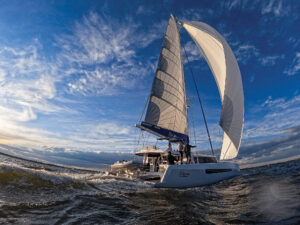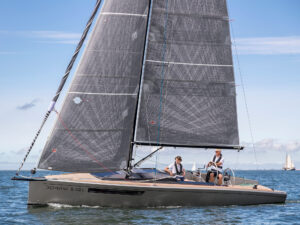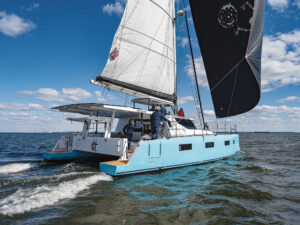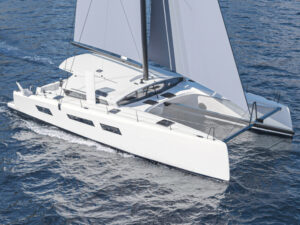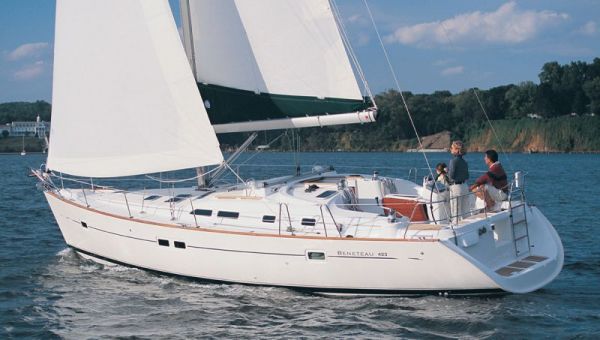
Beneteau’s new line of cruising sailboats underlines how firm is the company’s grasp not only on its customers’ desires but on how to meet them by building well-equipped boats at surprising prices—surprisingly low, that is. For anyone seriously in the market for a new boat in the 40-foot range, $190,000 is a mighty attractive starting point, so let’s look at what it buys.
First off, as anyone who follows our Classic Plastic series will be aware, today’s 40-footer is a lot bigger than its 20-year-old antecedent. Much of the extra volume comes from higher freeboard and longer waterlines and is most apparent in vast interior space.
The 423 divides this generous volume in alternative ways, a two-cabin and a three-cabin version. Both layouts have the same forward cabin and head, dining area (more or less), aft head, and engine compartment. The three-cabin boat has its galley along the port side, opposite the dinette, a nav desk to starboard with the head opposite, and two essentially identical big-berth cabins on either side aft. The two-cabin version, the one I sailed, has a short settee on the port side of the saloon with a nav desk aft of it, a large galley aft to starboard, and a cabin to port, the same as that in the three-cabin but with even more acreage covered with mattress. No doubt the three-cabin Beneteau 423 will wind up in large numbers in the charter fleets, and it will also suit owners who sail with families or friends. The two-cabin version seems destined for couples bent on long sessions of cruising by themselves or on day cruises, when they can turf the excess guests off the boat after dinner.
Around the saloon table, six can sit comfortably, eight at a squeeze, and the extra settee to port will fit up to a trio at drinks time. This seat will also serve as a slightly short sea berth, if you could engineer a lee cloth for it (and while you’re at it, for the starboard settee).
I could’ve happily spent a while stretched out on the port settee, back against the bulkhead and a book on my knee. However, I was there to “lift floorboards,” as we boat-testers say, most of which defied me because they were screwed down—which is the best thing to do with them if the bilge to which they give access is too shallow to be of much use for storage. While removable for inspection purposes, they won’t fly about the boat when conditions get ugly.
Shallow bilges are a direct result of two trends that have edged into cruising-boat design in recent years: long waterlines and light displacement. The displacement/length ratio (D/L) is used to predict how fast a boat might be for its length, but it’s just as useful for estimating storage space below the cabin sole. Lengthening the waterline for a given displacement means the volume below the waterline is stretched over a longer length, resulting in a shallower canoe body—a narrower waterline beam is hard to achieve with today’s beamy hulls—and, in turn, a shallower bilge and/or a higher cabin sole. If the cabin sole has to go up, so too, for maintaining headroom, does the freeboard. The 423’s shallow bilges and high freeboard both reflect its low D/L of 148.
Headroom in the 423’s spacious saloon is 6 feet 5 inches, and it tapers gradually downward as you go forward. The galley is blessed with this generous headroom, which gives hot air from the stove a direct path to escape through the well-placed hatch. The aft galley has lots of counter space over the fridge/freezer, which has both a front-opening section and a top-opening section. The heavy top lid has an air spring to hold it open. It also has a turn button to hold it down in the event of really bad weather.
This galley is almost enclosed by the partition alongside the companionway, so it should be really comfortable to work in while under way. In the three-cabin layout, the galley is a little more exposed, and a back to the centerline seat would be a great support and comfort when on port tack.
A safety rail protects the cook, but the stove, a handsome Force 10 in Beneteau livery, could jump out of its gimbal in a knockdown—the retaining tabs needed to be set or, better, a solid retainer fastened around the gimbal.
A proper navigation desk is a comforting place to sit in the morning while the coffee’s brewing and you’re listening to NOAA’s simulated announcer, Perfect Paul, enunciate the day’s weather forecast in peculiar accents and emphasis. Beneteau has thoughtfully provided one. Next to it is the electrical panel and area enough to mount several electronic devices. Under the concave seat is a roomy bin for the navigator’s other needs.
It might have been worth fighting the manufacturing engineer for another inch or two of width in the aft head, which is snug for a person of average build. That aside, it’s in a perfect location, convenient to cockpit and cabin.
Tucked under the cockpit, and with adequate clearance, is an enormous berth (even the smaller berth in the three-cabin is huge). For cruising, some of it could be easily sacrificed to provide storage space, and it would still provide a cozy seagoing berth for a couple. The cabin itself has generous walkabout space, too.
Disguising the outside appearance of copious volume is an art in itself, and here Groupe Finot, the designer of the Beneteau 423, demonstrates its finesse by masking the boat’s generous freeboard. The long waterline and boot top painted high on the hull help, and so too does a well-placed cove line, especially when it’s broken by hull ports. But it’s the cabin trunk that’s the saving grace. It has a line that’s interesting enough that it draws the eye away from the topsides. All in all, Finot has tackled the looks of this model in style.
And the Finot team has also worked its magic on the other bugaboo of modern, beamy boats: handling. We unrolled the mainsail (it’s also available with full battens and lazy jacks) and then the jib. While I was fiddling with the jib sheet as we set the boat on the wind, I realized that neither of us was steering. The boat didn’t seem to mind a bit, so we played with that theme for a while. According to the instruments, the wind was only blowing 10 to 12 knots true, and the Chesapeake was flat, but pretty much everywhere we put the boat relative to the wind, it steered itself happily with neither a hand on the wheel nor pressure on the wheel brake.
As is customary, the mainsail controls are on the aft end of the coachroof, steered through a battery of clutches to a pair of winches. Beneteau’s little loop gizmos keep the coiled tails orderly (why don’t all builders copy that?), but we still need an organist’s dexterity to flip the clutch levers in the right sequence and switch lines on the winches—less so on the in-mast furler than on the “traditional” main with its reefing lines. Snubbers for the traveler tag lines would lead them fairer to the winches and save incautious hands from rope burns.
Also earning a pat on the back is the choice of engine. Volvo has introduced a brand-new diesel engine with a welcome old-fashioned feature: a cruising rpm of 2,000. With the engine turning at that stately rate, the boat made a steady 7.2 knots, my teeth laid flat, and the crockery didn’t rattle in the lockers. At the 2,800-rpm limit, the boat surged along at its full-immersion hull speed of 8.5 knots—as attested to by the stern wave. The sound level in the cockpit was unobtrusive and below, at cruising revolutions, was quite acceptable. The engine is somewhat shoehorned into its compartment, but the entire companionway ladder hinges up, supported by a gas strut, to reveal the front end and its belts. I think I’d place a cover over the batteries, set right in front of the engine, lest I drop a wrench on the terminals. Key components are revealed by side openings.
In a remarkable demonstration of the 423’s maneuverability under power, the lad who showed me around the boat backed it all the way round a marina pier and directly into a slip. And no, this isn’t an attribute of a saildrive; the boat has a conventional shaft-and-prop arrangement, though with an integral FRP stern tube and strut that looks like a mini-skeg.
Finot and Beneteau, separately and together, have engineered a great many hulls. While it’s topical, and appropriate, to boast that a boat meets European Union requirements, the best codicil to that is Beneteau USA president Wayne Burdick’s statement to me that Beneteaus have sailed many millions of miles without a hull failure.
That he can make such a claim is a credit to the way the company handles potential conflicts between the need to engineer the boat’s components for their own sake and the need to engineer them for economy in manufacturing. Behind the saloon settee is the chainplate that ties the cap and aft-lower shrouds into the hull structure. A tie rod is attached to the underside of the deck fitting and, with a toggle, to a horizontal stainless-steel bar glassed into a web structure in the manner I first saw on high-tech one-off racing boats.
On deck, I found a nice sense of utility and security. The cockpit is both spacious and comfortable, and a permanent table serves as a brace when under way (the flaps snap off to be stowed, so they don’t get in the way when under way). A low bulwark adds a comforting touch when working the deck and augments structural stiffness at the hull/deck joint. The side deck gets a little narrow approaching the cockpit, and I got a little off balance negotiating the last couple of steps next to the dodger while carrying a couple of fenders. The lifeline gate is right there, too, so it’s not a good place to falter when it’s open.
Up forward, a horizontal windlass with a chain gypsy is protected by the lid for the capacious anchor-rode locker. A substantial twin-roller fixture incorporated into the stemhead fitting projects the anchor forward so it doesn’t ding the near-plumb stem on its way up or down. The substantial mooring cleats—there’s a pair forward, midships, and aft—will comfortably handle multiple lines.
Aft, the scooped transom provides a boarding and swim platform. Looking at the ventilation cowls overhanging this back porch, I envisioned big, curling, following seas trying to find their way in. That’s not a threat on most cruisers’ itineraries, but it’d be on my list of items to consider before a fall passage from New England to the islands.
Quibbles like that are easy to find on any boat and not hard to fix post delivery. Looking at the big picture, the Beneteau 423 has plainly benefited from the copious experience of both its builders and its designer. And it also benefits from being an ideal size. It’s a big 42-footer: You can fit it out with everything you could possibly need for cruising, and put a hard dinghy or RIB on the foredeck to boot.
Beneteau 423 Specifications:
LOA 41′ 8″ (12.70 m.)
LWL 38′ 7″ (11.75 m.)
Beam 12′ 11″ (3.94 m.)
Draft (std./opt.) 5′ 7″ (1.70 m.)/6′ 11″ (2.10 m.)
Sail Area (100% FT) 720 sq. ft. (66.9 sq. m.)
Displacement 19,000 lb. (8,618 kg.)
Ballast (std./opt.) 5,836 lb. (2,647 kg.)/5,569 lb. (2,526 kg.)
Ballast/Disp. .29/.31
Disp./L 148
SA/Disp. 16.2
Water 153 gal. (581 l.)
Fuel 53 gal. (200 l.)
Auxiliary 55-hp.Volvo D2-55
Designer Groupe Finot
Price (sailaway) $195,000
Beneteau USA Inc.
(843) 805 5000
www.beneteauusa.com
Jeremy McGeary is a Cruising World associate editor.
To read more Cruising World reviews of Beneteau sailboats, click here. To visit Beneteau America’s website, click here.

